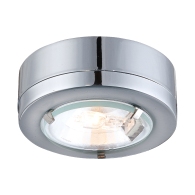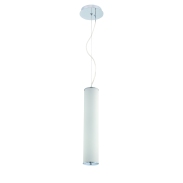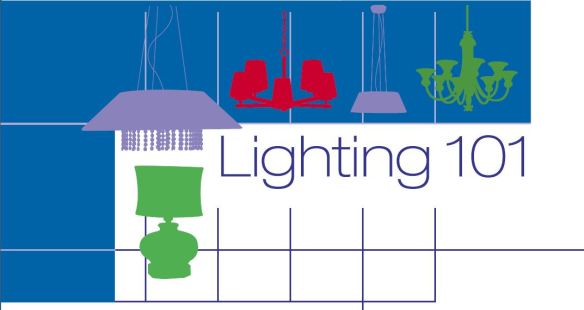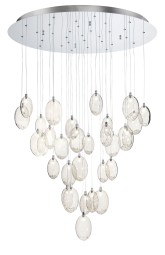There is much discussion about different light fixture designs; however the most important aspect of fixtures is the actual light source. There are many bulb options out there and this week we will be discussing the advantages, disadvantages, and optimal usages of each bulb type. This discussion is especially important now with the high-profile promotion of various ‘eco-friendly’ bulb options.
Efficacy- light source efficiency- How much of the electricity put into a bulb is lost to heat instead of converted into photons (light). The more energy lost to heat the lower a bulbs efficacy.
____________________________________________________________
Incandescent Bulbs
Incandescent are the original light bulb that brought electrical light to the masses. Although it uses an inefficient method for producing light, there are some definite advantages to incandescent bulbs. The main draw to the incandescent bulb is it produces a pleasant warm light that is effective for both directional and ambient light. Another advantage is the bulb itself is quite elegant, which lends itself well to bare-bulb applications such as chandeliers.
Some of the drawbacks to incandescent bulbs are low efficacy and a short lifespan. Incandescents run hot while in operation. The heat from the bulb is directly linked to the efficacy of the bulb. When converting electricity into light, some of the energy is also converted to heat. In incandescent,

Retto 1 lt Wall Sconce
halogens, and HID’s a large percentage of the energy is translated into heat instead of light (thus lowering its efficacy).
Incandescent Fixtures
Retto- This fixture comes in wall sconce and flushmount models. Using bulbs with large ‘antique’ style filaments, the fixtures highlight the beauty of the bare incandescent bulb.
____________________________________________________________
Halogen Bulbs
Halogen bulbs represent an advanced version of the standard incandescent bulb. The gas within the bulb allows for higher operational temperatures which produce a hotter light more closely resembling sunlight. Additionally the bulbs have a longer lifespan due to the properties of the gas. Halogen bulbs tend to be smaller than incandescents, which allow them to be used in a variety of applications such as under cabinet lighting and task lamps.
Halogen bulbs due to their small size and higher operational temperatures tend to have hotter outer glass while operating. Properly rated fixtures that have safety certifications are recommended to ensure safe use of halogens.
Halogen Fixtures
A large percentage of Eurofase’s lighting fixtures utilize G4, G9, or B10 halogen bulbs. This is due to their dependability, longevity, small size, and clean bright light.
Hazelton- This fixture utilizes the small, unobtrusive nature of G4 halogen bulbs to light glass spheres filled with crystals. The light source is ideal because it is slightly warmer than white light without being yellowish, which augments the amber hues of the glass.
Nava- This fixture exhibits how seamlessly halogen bulbs have displaced traditional incandescent bulbs. Utilizing the candelabra B10 bulb, the blue glass fixture exhibits the adaptability of the bulb’s light. Although slightly warmer than pure white, the light isn’t too warm so still looks great against a cool color!
____________________________________________________________
HID Bulbs
Also known as arc lamps, these are generally used for high-output applications like outdoor, streetlights, and warehouse lighting. The bulbs require ballast and an igniter to start, and are generally quite expensive. After ignition the bulb generally requires several minutes to reach optimal light output. Additionally, when turning off a lamp, it generally requires several minutes of cooling before it can be relit, commonly known as ‘hot restrike time’ (This can be avoided in smaller bulbs such as our under cabinet Xenon lights). Some examples of HID lamps are metal halide, sodium vapor, xenon, and the older mercury vapor and carbon arc bulbs.
HID bulbs generally have 2-3x the lifespan of incandescents, and have a higher efficacy (although still not as good as fluorescent and LED sources). Besides some metal halide lights (and Xenon) the bulbs do not produce ideal ‘living light’ and as such are not commonly used for indoor applications.

G4 Xenon MiniPuck
HID Fixtures
Eurofase supplies a variety of Xenon MiniPuck lights and under cabinet fixtures.
For architectural recessed and outdoor lights that utilize HID bulbs feel free to peruse the offerings on our website.
____________________________________________________________
Fluorescent Bulbs
Fluorescents are popular due to their long life, energy efficiency, even glow, and the plethora of fixtures and formats currently available. The bulbs require a ballast to start up, and some require a period of time to reach peak light output levels. The recently developed CFL’s are becoming a standard replacement for incandescent, and have an integrated ballast. Dimmable versions have been made available, closing the gap in usability. Fluorescents are good for providing ambient light, but are lacking when it comes to directional or high intensity needs.

Tubo 3 lt Medium Pendant
Fluorescent Fixtures
Tubo- This cleanly minimal fixture uses opal glass to diffuse and warm the gentle glow of a fluorescent T5 bulb.
Eurofase supplies an array of recessed, flush mount, and outdoor fixtures that utilize CFL and fluorescent bulbs.
____________________________________________________________
LED Bulbs
Developing from humble beginnings as faintly lit indicator lights on electronics, the LED has seen an explosion of development in recent years. Most of the current boom began with the development of white/blue light spectrum and high intensity LED bulbs. Boasting long life (beating out even fluorescents) and unmatched efficacy (matched only by induction lights-see below) LED’s are quickly becoming the fastest growing sector in the lighting business. The solid state light is also durable and easy to manufacture, meaning after R&D costs are recouped by companies, the high price they currently command will quickly become more reasonable.
The main drawback to LED’s is the linear nature of their light. LED’s make great recessed and directional lights, but challenges regarding diffuse light have been the focus of many creative ideas. Diffusers and arrays can mitigate much of the directional limitations of LED’s, and many innovations are still on the way. With the bulk of R&D funding going to LED and OLED development, this technology will continue to see growth, reduced cost, and innovation.
LED Fixtures
Viper- Elegant glass forms with pure white light to accentuate the undulating curves of the glass. As the focus on the form the neutrality of the light’s color helps to support instead of distract.
Eurofase is currently expanding its LED fixture offerings. Some fixtures to check out are the Pearla, and the plethora of new flush mounts such as the Alma, Wilson, Dallner, andRamata.
* Above documents are from Eurofase






















